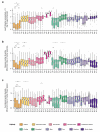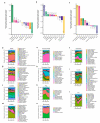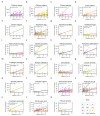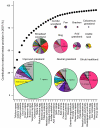Historical nectar assessment reveals the fall and rise of floral resources in Britain
- PMID: 26842058
- PMCID: PMC4756436
- DOI: 10.1038/nature16532
Historical nectar assessment reveals the fall and rise of floral resources in Britain
Abstract
There is considerable concern over declines in insect pollinator communities and potential impacts on the pollination of crops and wildflowers. Among the multiple pressures facing pollinators, decreasing floral resources due to habitat loss and degradation has been suggested as a key contributing factor. However, a lack of quantitative data has hampered testing for historical changes in floral resources. Here we show that overall floral rewards can be estimated at a national scale by combining vegetation surveys and direct nectar measurements. We find evidence for substantial losses in nectar resources in England and Wales between the 1930s and 1970s; however, total nectar provision in Great Britain as a whole had stabilized by 1978, and increased from 1998 to 2007. These findings concur with trends in pollinator diversity, which declined in the mid-twentieth century but stabilized more recently. The diversity of nectar sources declined from 1978 to 1990 and thereafter in some habitats, with four plant species accounting for over 50% of national nectar provision in 2007. Calcareous grassland, broadleaved woodland and neutral grassland are the habitats that produce the greatest amount of nectar per unit area from the most diverse sources, whereas arable land is the poorest with respect to amount of nectar per unit area and diversity of nectar sources. Although agri-environment schemes add resources to arable landscapes, their national contribution is low. Owing to their large area, improved grasslands could add substantially to national nectar provision if they were managed to increase floral resource provision. This national-scale assessment of floral resource provision affords new insights into the links between plant and pollinator declines, and offers considerable opportunities for conservation.
Figures











References
-
- Biesmeijer J, et al. Parallel declines in pollinators and insect-pollinated plants in Britain and the Netherlands. Science. 2006;313:351–354. - PubMed
-
- Potts SG, et al. Global pollinator declines: trends, impacts and drivers. Trends Ecol. Evol. 2010;25:345–353. - PubMed
-
- Vanbergen AJ, the Insect Pollinators Initiative Threats to an ecosystem service: pressures on pollinators. Front. Ecol. Environ. 2013;11:251–259.
-
- Goulson D, Nicholls E, Botías C, Rotheray EL. Bee declines driven by combined stress from parasites, pesticides, and lack of flowers. Science. 2015;347:1255957. - PubMed
-
- Carvell C, et al. Declines in forage availability for bumblebees at a national scale. Biol. Conserv. 2006;132:481–489.
Method references
-
- Preston CD, Pearman DA, Dines TD. New Atlas of the British and Irish Flora: An Atlas of the Vascular Plants of Britain, Ireland, The Isle of Man and the Channel Island. Oxford University Press; Oxford, UK: 2002. p. 910.
-
- Fitter AH, Peat HJ. The Ecological Flora Database. J. Ecol. 1994;82:415–425. [ http://www.ecoflora.co.uk]
-
- Corbet SA, et al. Native or exotic? Double or single? Evaluating plants for pollinator-friendly gardens. Ann. Bot. 2001;87:219. - PubMed
-
- Carvalheiro LG, Barbosa ERM, Memmott J. Pollinator networks, alien species and the conservation of rare plants: Trinia glauca as a case study. J. Appl. Ecol. 2008;45:1419–1427.
-
- BSBI, Botanical Society of the British Isles 2011 [ http://www.botanicalkeys.co.uk/flora/]

